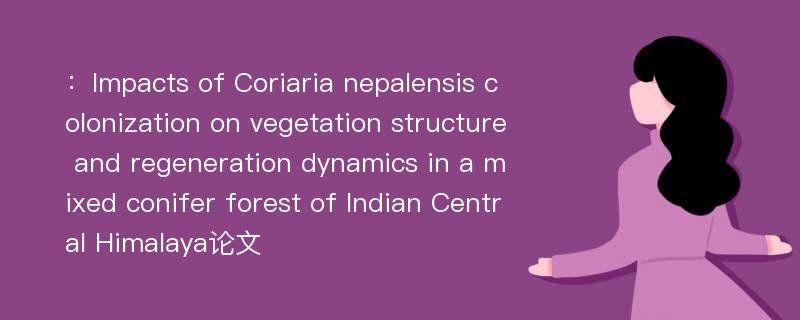
本文主要研究内容
作者(2019)在《Impacts of Coriaria nepalensis colonization on vegetation structure and regeneration dynamics in a mixed conifer forest of Indian Central Himalaya》一文中研究指出:This study evaluated impacts of Coriaria nepalensis Wall.colonization on soil characteristics,vegetation structure and composition,regeneration status and expected future compositional changes,biomass and carbon stock in tree species of a mixed conifer forest of Central Himalaya.Three sites(1 ha each in an old landslide area)differing in Coriaria density(low:20 individuals ha-1;medium:120 indiv.ha-1;high:190 indiv.ha-1)were used to enumerate the tree species.A total of 9 tree species and 2830 individuals were recorded from the three study sites that represented a gradient of Coriaria density.Number of species varied from 3 to 7 and the individuals from 690 to 1270 per site with lowest numbers at low Coriaria density and highest at medium Coriaria density.The number of seedlings increased with increasing Coriaria density,and the sites were unique in their seedling composition,indicating marked temporal dynamics.Site wise regeneration analysis showed that regeneration was poor at the site with low Coriaria density and good at the high-density site where many species emerged as seedlings.These results indicate that the ameliorative effects of Coriaria in terms of soil buildup,and accumulation of nutrients and organic matter helped more species to colonize the area.This facilitative ability of Coriaria can be used to restore degraded forest ecosystems of Indian Central Himalaya.
Abstract
This study evaluated impacts of Coriaria nepalensis Wall.colonization on soil characteristics,vegetation structure and composition,regeneration status and expected future compositional changes,biomass and carbon stock in tree species of a mixed conifer forest of Central Himalaya.Three sites(1 ha each in an old landslide area)differing in Coriaria density(low:20 individuals ha-1;medium:120 indiv.ha-1;high:190 indiv.ha-1)were used to enumerate the tree species.A total of 9 tree species and 2830 individuals were recorded from the three study sites that represented a gradient of Coriaria density.Number of species varied from 3 to 7 and the individuals from 690 to 1270 per site with lowest numbers at low Coriaria density and highest at medium Coriaria density.The number of seedlings increased with increasing Coriaria density,and the sites were unique in their seedling composition,indicating marked temporal dynamics.Site wise regeneration analysis showed that regeneration was poor at the site with low Coriaria density and good at the high-density site where many species emerged as seedlings.These results indicate that the ameliorative effects of Coriaria in terms of soil buildup,and accumulation of nutrients and organic matter helped more species to colonize the area.This facilitative ability of Coriaria can be used to restore degraded forest ecosystems of Indian Central Himalaya.
论文参考文献
论文详细介绍
论文作者分别是来自Journal of Forestry Research的,发表于刊物Journal of Forestry Research2019年01期论文,是一篇关于,Journal of Forestry Research2019年01期论文的文章。本文可供学术参考使用,各位学者可以免费参考阅读下载,文章观点不代表本站观点,资料来自Journal of Forestry Research2019年01期论文网站,若本站收录的文献无意侵犯了您的著作版权,请联系我们删除。
